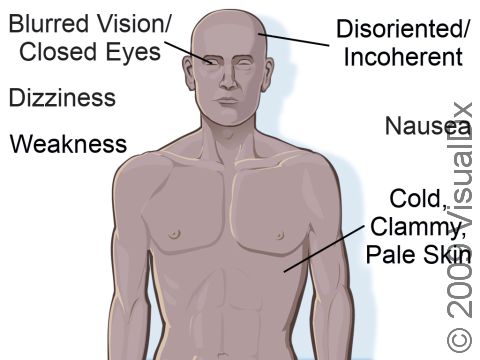Fainting, First Aid
Fainting is a form of unconsciousness that is quick and brief, often due to low blood sugar or standing in one place for too long. Fainting can also be caused by a more serious medical matter. Unconsciousness is an abnormal state in which a person is not alert and not fully responsive to his/her surroundings.
Unlike when a person is asleep, someone who has fainted and is unconscious cannot cough, clear his/her throat, or turn his/her head if in distress. When unconscious, a person is in danger of choking, making it very important to keep the airway clear while awaiting medical care.
First Aid Guide
In the event of fainting, attempt the following self-care measures:
- If possible, try to prevent someone who is fainting from hitting the ground.
- Lay the person down on the ground, face up, and elevate his/her feet 8–12 inches.
- Loosen any constrictive clothing.
- Apply a cool, wet compress to the person’s forehead.
- Attempt to keep the person from standing up until fully recovered.
Note:
- If the person vomits while he/she is unconscious, quickly turn him/her to allow the fluid to drain while protecting the person’s airway.
- Do not attempt to give an unconscious person anything by mouth.
- Do not shake or slap a person who has fainted to attempt to make him/her regain consciousness.
If the person was injured while fainting, give first aid for any injuries (eg, bumps, bruises, or cuts) accordingly. Bleeding should be stopped with direct pressure.
Who's At Risk?
People with the following medical conditions are at an increased risk of fainting:
- Low blood sugar (hypoglycemia)
- Anemia
- Any condition in which there is a rapid loss of blood, such as from internal bleeding
- Heart and circulatory problems
- Heat stroke or heat exhaustion
- Eating disorders (eg, anorexia and bulimia)
- Toxic shock syndrome
Additionally, those who stand in one place for a long time, particularly in high heat, are prone to fainting. Further, fainting can be caused by anxiety (eg, sudden stress or fright), severe pain, suddenly changing body position (eg, standing up too quickly), and certain medications.
Signs & Symptoms
A person who faints often experiences dizziness, nausea, weakness, and/or blurred vision prior to losing consciousness, and they may have cold, clammy, pale skin. The person may be disoriented, incoherent, motionless, and silent.
Treatments
If the person was injured during the fall, the physician will treat those injuries (eg, stopping bleeding, giving stitches).
As fainting can be caused by many underlying conditions, the physician will conduct tests to determine the scope and treat the illness or injury accordingly.
Visit Urgency
If the person does not regain consciousness quickly (eg, within 5 minutes), is elderly, or has a medical problem, call emergency medical services. While not typical, fainting can be a sign of serious illness, so seek treatment by a medical professional to determine the cause and provide proper treatment.
Last modified on October 6th, 2022 at 2:46 pm

Not sure what to look for?
Try our new Rash and Skin Condition Finder
